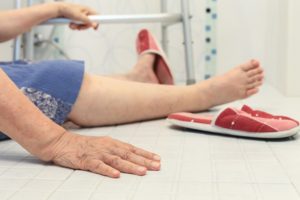There are many concerns and worries families experience as their loved one’s age. Concerns such as safety and maintaining quality of life cause much confusion and questioning as to whether we are doing the right thing or doing enough to keep them safe and happy. To help address these issues, we at Brookville Home Care are happy to provide continuing articles addressing these important and common considerations.
Safety must haves in the home:

The number #1 worry is falls. Important points to consider:
Remove or reduce as much as possible the use of throw/scatter rugs and area rugs that seniors have to constantly navigate over. Weakness, reduced vision and mobility issues reduce the dexterity it takes to lift the foot enough to clear heights of some rugs or recover stability when a rug slips underfoot. Walkers and canes can catch the edges and are suddenly not in right position to stabilize the person. If it is not possible to remove all these rugs make sure they are secured to floors with non-slip products such as two-sided tapes or non-skid pads. Bathrooms are where a lot of falls happen and where there are very few surfaces for a “soft landing” (do not mistake those fluffy bathroom mats as providing a cushion for falls). Bath mats should only be used during shower/bath times and hung up to dry immediately afterwards. If there must be something to cover the floor choose a flat weaved, rubber backed floor mat type of rug, just beware of the height of the edge, as flat to the floor as possible.
Let there be light!
Adding more light helps with seniors experiencing the common vision changes that come with ageing. Add more light! Sunlight is always a great choice, make it easy to draw open curtains and shades and make it a daily routine. Also adding more ambient light such as lamps, sconces or ceiling lights in those dark hallways or stairways ensures more safety. Connecting these lights to switches will assure more use and more safety. Change out incandescent light bulbs with cooler lighting such as fluorescent bulbs, LED and halogen. The newer fluorescents such as T8 (faster start up), T5 (smaller than conventional fluorescents) and T5HO (brighter) are good choices. Having dimmable lights also helps, with controls within easy reach. Being able to brighten light while eating or lower lighting near bedtime which helps the body’s circadian rhythm adjust for better sleep. Tip: Having brighter lighting at entryways/exits makes it easier for vision impaired seniors to adjust to the brighter outdoor light as they step outside. Finally, have task lighting available in addition to regular lighting where routine tasks such as reading, taking medication and hobbies are done. Pendants and adjustable lamps are great for task lighting.
Provide stability:
Adequate grab bars secured near the toilet, outside and inside shower/bath with anti-slip grips are a must. Vertical bars are easier for seniors with arthritic hands but horizontal bars may make it easier to move up and down from seating such as the toilet. While some of the suction types seem secure they can be unreliable when they are suddenly grabbed. The extra effort and expense of having grab bars properly installed will provide better peace of mind for you and your loved ones.
Additionally, handrails on both sides of inside and outside stairs
Helpful tips:
-
Label medications with clear large print to avoid mistakes. Better yet, have a family member or friend come in weekly to make up pill boxes clearly marked with days and times. You can do several at a time if you wish. This will also provide a much needed visit to seniors living alone.
-
According to the NFPA, 3 of 5 fire deaths occurred in homes with no alarms or dysfunctional ones. Make sure there are enough smoke and carbon monoxide alarms in the home. Test them at least twice a year when you reset the clocks. It is now law that they be replaced with 10 yr sealed batteries when switching out old for new. There should be alarms placed in bedrooms, hallways, on each floor. Make sure they are placed at least 10 ft from cooking appliances.
-
Most walkers have front wheels for ease of navigation. But these wheels make it difficult to move through some doorways (especially bathrooms) safely using a walker. These wheels are easily detached and rotated from the outside to the inside of the front walker legs. Additionally, check the walker for correct height. Standing as straight up as possible the walker handles should come to the height of the wrists. Those back legs of walkers often make it difficult to glide walker over floor with ease, necessitating repeated lifting by the senior which can throw them off balance. You can purchase a product called skids or use tennis balls. Carefully cut an X in the ball and pop the foot of the back legs into the balls.
